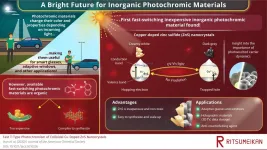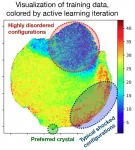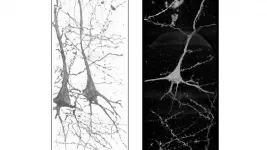(Press-News.org) An analysis of U.S. county-level data found a strong association between jail incarceration and death rates from infectious diseases, chronic lower respiratory disease, drug use, and suicide, in a new study by Columbia University Mailman School of Public Health. The researchers found this was the case to a lesser extent for heart disease and cancer. The study is the first to examine the link between the expansion of the jail population and multiple specific causes of death at the county level, and adds to the growing body of evidence suggesting that decarceration strategies would improve public health. Findings are published online in the journal Lancet Public Health.
"Our findings underscore public health benefits of reducing jail incarceration and the importance of interventions to mitigate the harmful effects of mass imprisonment on community health including community-based treatment for substance use disorder and greater investment in social services," said Sandhya Kajeepeta, PhD candidate in Columbia Mailman School of Public Health's Department of Epidemiology, who led the research.
Using county jail incarceration rates and county-level mortality data in the U.S. across 1,094 counties between 1987 and 2017 the researchers estimated that every 1 per 1,000 population increase in the local jail incarceration rate was associated with a 6.5 percent and 5 percent increase in death rates from infectious diseases and chronic lower respiratory disease respectively, and around a 2.5 percent rise in mortality from drug use and suicide, in the county population (aged 75 years or younger) during the following year--after accounting for the effects of county-level factors such as crime, poverty, racial demographics, and unemployment.
Increases in county-level incarceration were also associated with smaller increases in county death rates from heart disease (2.1 percent increase), unintentional injury (1.5 percent, cancer (1.4 percent), diabetes (1.3 percent), and cerebrovascular disease (1 percent) over the subsequent year.
"As we anticipate the Biden administration's plans to address persistent mass criminalization and incarceration, our findings underscore the role of local jail incarceration as an important independent contributor to all major causes of premature death in the counties in which they are located," said Kajeepeta. "Our findings provide further evidence of the population-level public health harms of mass incarceration. With U.S. correctional facilities reporting some of the highest COVID-19 infection rates in the nation, the pandemic highlights the immediate need for decarceral strategies to massively reduce the number of people held in our nation's jails and prisons to protect the lives of incarcerated people and control infectious disease spread in the community."
The U.S. has the highest incarceration rate in the world. At any given time, county jails across the nation house more than 730,000 inmates that are typically serving less than a year or awaiting trial. However, many more people (over 11 million) enter jail every year (most awaiting trial)--with generally 200,000 people passing in and out every week. Evidence indicates that Black Americans are incarcerated in local jails at four times the rate of white Americans.
In the study, the authors used data from the U.S. National Vital Statistics System together with jail incarceration data for 1,094 counties (36 percent) of all U.S. counties) from the Vera Institute of Justice between 1987 and 2017, to model associations between jail incarceration and nine common causes of death--cerebrovascular disease, chronic lower respiratory disease (e.g., emphysema, chronic obstructive pulmonary disease), diabetes, heart disease, infectious disease, cancer, drug use, suicide, and unintentional injury--for county residents aged younger than 75 years. The median increase in county jail incarceration rate over the study period was 1.9 per 1,000 population, with some counties experiencing an increase of more than 20 per 1,000 population.
The researchers hypothesized that the impact on a community from causes of death with longer latency periods, such as heart disease and cancer, are felt over time, so they assessed the medium- (5-year) and long-term (10-year) effects of jail incarceration as well as the short-term (1-year) impact. They adjusted for county-level characteristics and changes over time that might affect the relationship between incarceration and mortality, including local poverty and crime rates, unemployment levels, percentage of county residents who were Black, and state political party control.
While increases in the county jail incarceration rate were linked with increases in mortality rates for all causes of death during the subsequent year, these associations weakened over time, particularly for infectious disease and suicide--with a 5 percent and 2.5 percent decline in county mortality respectively after 10 years. The decline was less pronounced for causes of death with generally longer latency periods including cancer.
"Not only do county jails operate as revolving doors facilitating the spread of infectious disease in the community, but they are often dangerously overcrowded, with poor ventilation and substandard healthcare," said co-author Dr. Abdul El-Sayed from Detroit's Wayne State University, who is also the city's former health director. "Incarceration takes working-age people out of their local communities, separates families, and disrupts social ties and support networks. When combining that economic hardship with the money government spends on incarcerating people instead of investing in social services to support them, jail systems ultimately hurt the people the system thinks it's 'correcting'."
The authors say that racial disparities in the nation's criminal justice system compound existing socioeconomic and racial health disparities. "Responses to the most pressing public health challenges, including the COVID-19 pandemic and opioid epidemic, require public health to reckon with mass criminalization and mass incarceration," noted Seth J. Prins, PhD, assistant professor of epidemiology at Columbia Mailman School, the study's senior author. "We need to disinvest from the carceral systems that have displaced public health and social infrastructures. Decarceration policies, like investments in community-based substance use treatment, housing, education, and jobs, can produce broad mortality benefits and potentially save thousands of lives."
INFORMATION:
The study was funded by the National Institute on Drug Abuse.
Columbia University Mailman School of Public Health
Founded in 1922, the Columbia University Mailman School of Public Health pursues an agenda of research, education, and service to address the critical and complex public health issues affecting New Yorkers, the nation and the world. The Columbia Mailman School is the seventh largest recipient of NIH grants among schools of public health. Its nearly 300 multi-disciplinary faculty members work in more than 100 countries around the world, addressing such issues as preventing infectious and chronic diseases, environmental health, maternal and child health, health policy, climate change and health, and public health preparedness. It is a leader in public health education with more than 1,300 graduate students from 55 nations pursuing a variety of master's and doctoral degree programs. The Columbia Mailman School is also home to numerous world-renowned research centers, including ICAP and the Center for Infection and Immunity. For more information, please visit http://www.mailman.columbia.edu.
Highlight
Racial disparities in access to kidney transplantation persist in the United States. New research indicates that registering Black patients on the kidney transplant waitlist at a slightly higher level of kidney function compared with white patients might lessen racial inequality in patients' wait time prior to kidney failure onset, and ultimately improve racial equity in access to kidney transplantation.
Washington, DC (February 23, 2021) -- Despite efforts to address them, racial disparities in access to kidney transplantation persist in the United States. New research published in an upcoming issue of JASN indicates that policy changes surrounding patients' eligibility to be put on kidney transplant waitlists might help address these disparities.
There are studies ...
MINNEAPOLIS - More than two-thirds of people with migraine do not get enough exercise, according to a preliminary study released today, February 23, 2021, that will be presented at the American Academy of Neurology's 73rd Annual Meeting being held virtually April 17 to 22, 2021. The study found that people who do get a minimum of two-and-a-half hours of moderate to vigorous exercise a week had a reduced rate of migraine triggers like stress, depression and sleep problems.
"Migraine is a disabling condition that affects millions of people in the United States, and yet regular exercise may be an effective way to reduce the frequency and intensity of some migraines," said study author Mason Dyess, D.O., of the University ...
One in four women over age 65 is unable to walk two blocks or climb a flight of stairs. Known as mobility disability, it is the leading type of incapacity in the United States and a key contributor to a person's loss of independence. New research from Herbert Wertheim School of Public Health and Human Longevity Sciences at UC San Diego suggests that light-intensity physical activity, including shopping or a casual walk, may protect mobility in older women.
Published in the February 23, 2021 online issue of JAMA Network Open, researchers found that women ...
Texas A&M University researchers have designed a reinforcement-based algorithm that automates the process of predicting the properties of the underground environment, facilitating the accurate forecasting of oil and gas reserves.
Within the Earth's crust, layers of rock hold bountiful reservoirs of groundwater, oil and natural gas. Now, using machine learning, researchers at Texas A&M University have developed an algorithm that automates the process of determining key features of the Earth's subterranean environment. They said this research might help with accurate forecasting of our natural reserves.
Specifically, the researchers' algorithm ...
Isn't it convenient when office building windows adaptively darken according to the intensity of sunlight? Or when standard glasses turn into sunglasses under the sun and switch back as you enter a building? Such feats are possible thanks to photochromic materials, whose optical (and other) properties change radically when irradiated by visible or ultraviolet light.
Today, virtually all fast-switching photochromic materials are made using organic compounds. Unfortunately, this makes them considerably expensive and complex to synthesize, requiring multi-step processes that are difficult to scale up for mass production. So, despite the myriad ...
Thuwal/Helsinki/Leipzig. Alkanes, an important component of fuels for combustion engines and an important class of urban trace gases, react via another reaction pathways than previously thought. These hydrocarbons, formerly called paraffins, thus produce large amounts of highly oxygenated compounds that can contribute to organic aerosol and thus to air pollution in cities. An international research team has now been able to prove this through laboratory experiments with state-of-the-art measurement technology at the University of Helsinki and the Leibniz Institute for Tropospheric ...
LOS ALAMOS, N.M., February 23, 2021--A revolutionary machine-learning (ML) approach to simulate the motions of atoms in materials such as aluminum is described in this week's Nature Communications journal. This automated approach to "interatomic potential development" could transform the field of computational materials discovery.
"This approach promises to be an important building block for the study of materials damage and aging from first principles," said project lead Justin Smith of Los Alamos National Laboratory. "Simulating the dynamics of interacting atoms is a cornerstone of understanding and developing new materials. Machine learning methods are providing computational scientists new tools to accurately and efficiently conduct these atomistic ...
Neuroblastoma is a cancer that develops in nerve tissue, most commonly in the glands around the kidneys. The gene MYCN is overexpressed in 20-25% of neuroblastoma, and MYCN-amplified neuroblastoma contributes to a considerable percentage of pediatric cancer-related deaths.
Anthony Faber, Ph.D., and a team of researchers at VCU Massey Cancer Center were awarded a grant from the American Cancer Society to study how MYCN and an abundance of iron can drive cancer cell death in neuroblastoma and potentially be targeted with novel treatments. This award is the first part of a potential two-stage grant worth a combined total of $600,000.
"Iron is a double-edged sword in a cancer cell. It can help the cancer grow and survive, but it also creates ...
Schizophrenia, a chronic, neurological brain disorder, affects millions of people around the world. It causes a fracture between a person's thoughts, feelings and behavior. Symptoms include delusions, hallucinations, difficulty processing thoughts and an overall lack of motivation. Schizophrenia patients have a higher suicide rate and more health problems than the general population, and a lower life expectancy.
There is no cure for schizophrenia, but the key to treating it more effectively is to better understand how it arises. And that, according to Ryuta Mizutani, professor of applied biochemistry at Tokai University in Japan, means studying the structure of brain tissue. Specifically, it means comparing the brain tissues of schizophrenia patients with those ...
Even as more people are logging onto popular video chat platforms to connect with colleagues, family and friends during the COVID-19 pandemic, Stanford researchers have a warning for you: Those video calls are likely tiring you out.
Prompted by the recent boom in videoconferencing, communication Professor Jeremy Bailenson, founding director of the Stanford Virtual Human Interaction Lab (VHIL), examined the psychological consequences of spending hours per day on these platforms. Just as "Googling" is something akin to any web search, the term "Zooming" has become ubiquitous and a generic verb to replace videoconferencing. Virtual meetings have skyrocketed, with hundreds of millions happening daily, as social distancing protocols have kept people apart physically.
In ...




